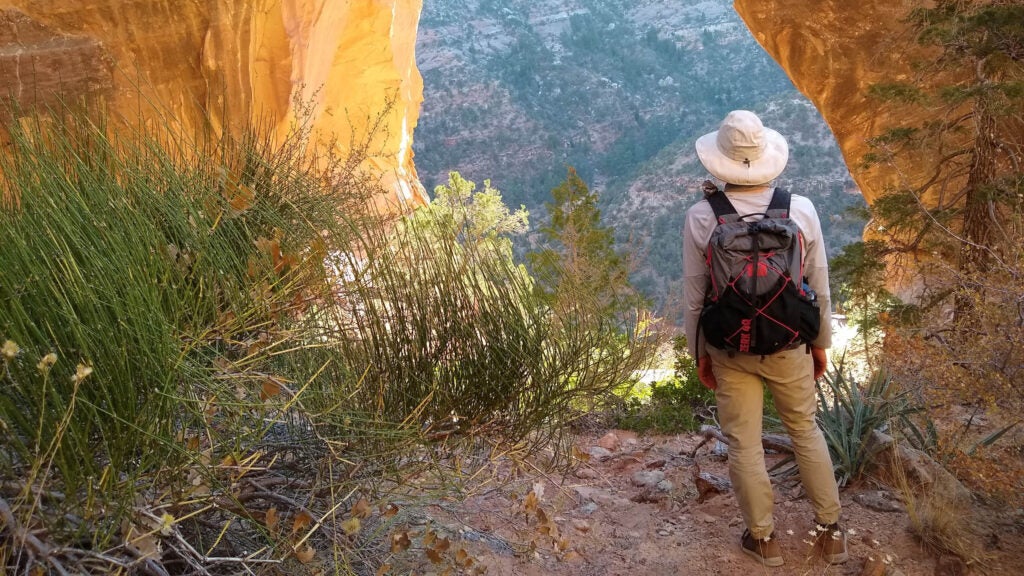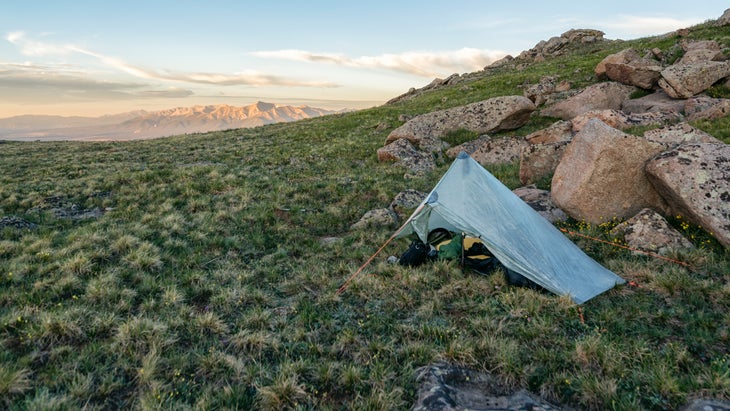



Ten pounds. If there’s one number associated with ultralight backpacking, that’s it: For decades, a ten-pound baseweight has served as a de facto cutoff for inclusion in the ultralight club. Beat that mark, and you’re an official ultralighter. Miss it, even by a few ounces, and you have some more toothbrush-handle cutting to do.
Of course, that’s only true if you think baseweights are important, and that there’s a strict definition of what qualifies as ultralight (or not.) Twelve years ago, when I set off on my Appalachian Trail thru-hike, ten pounds seemed like the most important number in the world. Now, I’m not so sure that worrying about baseweight is worth the time, or that ultralight hiking should be defined by a such an easily digestible number.
It’s worth taking a quick look into where ultralight backpacking and the ten-pound baseweight originated. Though people have probably been trimming pack weight and traveling in an “ultralight” manner for centuries, the modern incarnation of ultralight hiking can be traced to Ray Jardine and his PCT Hiker’s Handbook, published in 1992. Jardine’s “Ray-Way” tarps and frameless backpacks have basically served as the guiding vision for ultralight gear design ever since. But while Jardine advocated for lightweight gear, he never talked much about baseweight, or put a number on how low a baseweight should be.
Though it’s hard to say exactly where the ten-pound cutoff comes from, it’s easy to find references to it in online communities like Backpacking Light dating back at least 20 years. From there, it has certainly spread. It’s appeared in Youtube videos, gear guides, and the pages of our own Backpacker magazine. You’ll hear it mentioned in A.T. shelters and on the sales floor at gear shops. There might not be an official definition of ultralight hiking, but today, most folks know that ten pounds is the de facto limit.
Despite its persistence, the ten-pound baseweight is no longer an accurate mark, especially among the truly gear-obsessed who spend more time on Lighterpack than on the trails. Twenty years ago, discussing an “ultralight baseweight” made a certain kind of sense. Back then, a novice hiker who walked into an outdoors store to buy gear for an A.T. thru-hike would leave with 60 or 70 pounds to load into a monstrous pack. Spending the time cutting down to a ten-pound baseweight was a real achievement, as least in terms of research. Today, that’s not the case. If you’re fully committed to buying the best ultralight gear, a six- or seven- pound baseweight is easy to accomplish, and only requires a few quick Google searches. You can achieve a ten-pound baseweight shopping at REI. If you’re committed to defining an ultralight load, ten pounds is no longer the benchmark to use.

But that’s not really the point. The point is that the ten-pound baseweight is part of a rigid orthodoxy that never served backpackers—ultralight or otherwise—particularly well. Andrew Skurka, the professional thru-hiker turned trip guide, has written several times about how little he thinks of letting a baseweight determine how he packs for a particular trip. And I’ve heard from many other experienced thru-hikers who obsessed about their baseweight before starting their first long hike, only to add durable and comfortable gear back into their kit as the miles added up, realizing that they didn’t care whether their baseweight was nine pounds or 12. The best evidence that baseweights don’t matter is that the most experienced ultralight hikers eventually stop thinking about them.
The true challenge of going ultralight isn’t to buy the lightest gear, but to carry the right stuff on every trip. If your kit meets some predefined weight limit, but doesn’t keep you happy, comfortable, or safe, it’s failing. That criteria changes for every trip, and ultralighters have a special term for pushing the envelope too far: “stupid light.” Usually, we think of that in dramatic terms, like using a summer-weight sleeping bag in a snowstorm, or leaving behind a bear canister in grizzly territory. But there are many ways to be stupid light. What if you have all of the insulating layers you need, but get blisters from four days of swampy hiking in trail runners? What if you carry extra food and water, but stay up all night swatting mosquitoes because you have no bug protection at all? Going stupid light doesn’t have to be a matter of life and death, and it doesn’t always have to do with how much weight you’re carrying—but leaving gear behind to hit a goal baseweight is a surefire way to experience going stupid light for yourself.
It’s time we stopped talking about baseweights so much. By “we” I’m referring to gear companies, salespeople, and media outlets, but mostly the online community of ultralight hikers who are probably more influential than any traditional source of information. Why do we so often advise newer backpackers to make purchases with a specific baseweight as the goal? Probably because it’s easier than telling them the truth—that no one else can determine how comfortable they will be using a frameless pack, or sleeping on a torso-length pad, or eating cold-soaked food.
As a writer who often focuses on ultralight topics, I understand that it’s a lot easier to put together a simple “ten-pound gear list” than it is to dive into all of the nuances of how different gear can make or break a trip. Rather than focusing on a number, I have another definition of an ultralight hiker: someone who carries the minimal amount of gear needed to maximize their safety, comfort, and enjoyment on a given trip. That kind of know-how is hard to impart through the written word, and for most hikers, there’s simply no way to replace going out there and experiencing it for yourself. If you do that, and end up carrying a 13-pound baseweight, you haven’t failed. In my book, you’ve found your own definition of ultralight.

